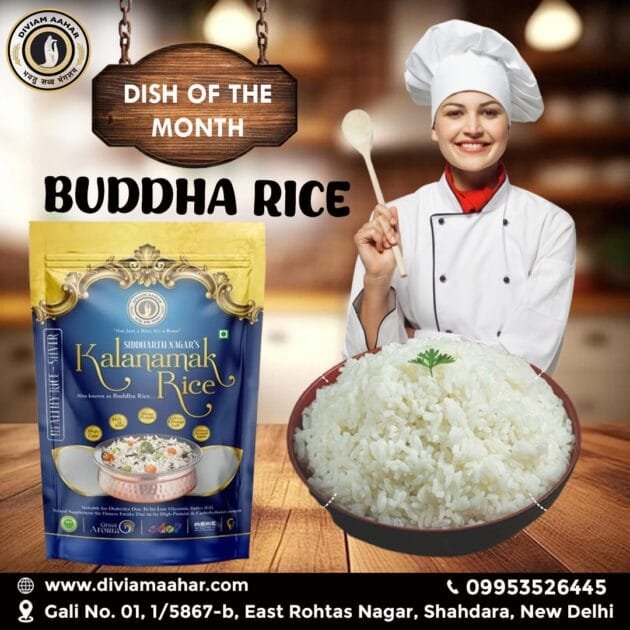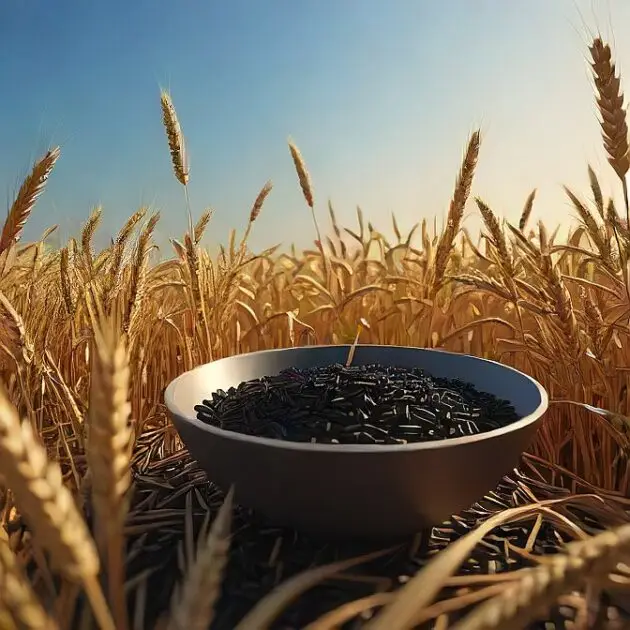Table of Contents[Hide][Show]
Kalanamak is a type of aromatic rice grown in Nepal and India. The name literally means black husk, a reference to its black husk (“kala” meaning black, “namak” meaning salt). This aromatic rice has been grown since the Buddhist period that is 600 BC. Its popularity is high in Himalayan Tarai region of Nepal, especially Kapilvastu, and eastern Uttar Pradesh in India. It is often called the “scented black pearl.” The Food and Agriculture Organization of the United Nations has highlighted it in the book Specialty Rices of the World.
Decline in Cultivation
The acreage under Kalanamak rice has declined sharply, forcing it to the brink of extinction due to a number of factors:
Panicle blast epidemics in 1998 and 1999.
The tall stature of the crop, causing lodging.
Long harvest time (6 to 7 months).
Poor quality seeds and no research support.
Until the 1990s, Kalanamak rice formed more than 10% of the total rice cultivation in Siddharthnagar, but by 2002, it had fallen to less than 0.5%.
Historical Significance
Kalanamak rice has a history dating back to the Buddhist period. Grains similar to Kalanamak were found when Kapilvastu, the ancient kingdom of King Śuddhodana, father of Gautama Buddha, was excavated. It is said that Buddha distributed Kalanamak rice as prasad during his visit to Kapilvastu after attaining enlightenment. He told the villagers to sow it in marshy areas, saying that its unique smell would remind them of him.
During British rule, efforts for preserving Kalanamak rice were initiated by the Englishmen such as William Pepe and Edcan Walker. Reservoirs in Bajha, Marthi, Moti, and Majhauli were developed for the production of this rice. Kalanamak was sent to England. The post-independence negligence had affected the productivity level.

Geographical Indication (GI) Tag
In 2012, the Kalanamak rice was registered by the Government of India with GI tag. Definition of geographical location where it would be cultivated with 11 districts in Uttar Pradesh’s Zone 7: Sidharthnagar, Sant Kabirnagar, Maharajganj, Basti, Gonda, and Gorakhpur are included. Therefore, only paddy grown at this place shall be termed Kalanamak.
Quality and Varieties
Kalanamak rice is a non-basmati rice with medium slender grains. It has four main varieties:
KN 3
Bauna Kalanamak 101
Bauna Kalanamak 102
Kalanamak Kiran (developed by Dr. R.C. Chaudhary)
Its aroma, described as a “gift of Buddha,” is stronger than that of Basmati rice. Kalanamak elongates after cooking, yielding soft and fluffy grains with medium amylose content (~20%), making it softer and more cohesive compared to Basmati rice.
Health Benefits
Kalanamak rice is rich in micronutrients such as iron and zinc. It has 11% protein, nearly double the protein content of common rice varieties. Its low glycemic index (49%-52%) makes it suitable for diabetics. Under India’s Nutri-Farm scheme, Kalanamak rice was identified as a “nutri-crop” to address nutritional deficiencies in vulnerable populations.
Government Initiatives
The Government of Uttar Pradesh promotes Kalanamak rice under the “One District One Product” (ODOP) scheme. The Government of Uttar Pradesh has established a Common Facility Centre in Siddharthnagar and is planning to set up a Kalanamak Rice Research Centre to promote its cultivation and production. In 2021, Siddharthnagar was awarded the Prime Minister’s Award for Excellence in Public Administration for promoting Kalanamak rice under this scheme.
Usage and Cooking

Kalanamak rice is very aromatic and used for a variety of dishes such as pulao, kheer, stir-fries, and salads. It should be soaked for 3-4 hours before cooking and requires 2-3 whistles in a pressure cooker for the best texture.
Availability in the Market
Organic and polished forms of Kalanamak rice are rich in essential carbohydrates, proteins, and micronutrients. Brands like Brightcrop and KisaanSay market this rice as a premium product with health benefits, emphasizing its organic cultivation and unique flavor profile.
Distinguishing Features
It is resistant to panicle blast, stem rot, and brown spot diseases.
It is superior to Dehradun Basmati in disease resistance.
It is called “Queen of Fragrance” because of its strong aroma.
Fit for daily consumption in order to keep the metabolism healthy.
Kalanamak rice, because of its historical, nutritional, and aromatic characteristics, has an important position in Indian and Nepalese cultures. Conserving and promoting this “scented black pearl” is crucial in order to preserve its legacy and to promote sustainable agriculture.
About Us: Kalanamak Rice – A Heritage of Flavor and Wellness
Kalanamak Rice is a custodian of a legacy which dates back hundreds of years to celebrate the rich heritage and unmatched aroma of one of India’s most prized rice varieties. Nicknamed as the “Basmati of the East,” Kalanamak rice is more than just a grain; it’s a story born from the fertile soils of Uttar Pradesh and infused with tradition, culture, and sustainability.
We set out with a purpose – to save and promote this traditional variety that, for its superlative aroma, flavor, and various medicinal properties, is revered since the earliest of times. Each speck of Kalanamak rice is an account of God’s generosity and humanity’s dedication. Our farmers use organic farming practices as well as long-standing traditional approaches to cultivate authentic and pure crop harvests.
Kalanamak rice is famous not only for its black husk and short grain but also for its nutritional richness. Packed with antioxidants, iron, and essential nutrients, it stands as a healthier alternative for modern lifestyles without compromising on taste.
Our commitment extends beyond the fields. We connect global consumers with this incredible heritage, where every plate is a story of tradition, innovation, and wellness. Join us in savoring the essence of Kalanamak rice, a timeless treasure for every table.

Top 20 Brands of Kalanamak Rice
Diviam Aahar Private Limited is a trusted name in premium-quality Kalanamak Rice, proudly sourced from the fertile fields of Siddharth Nagar, India. Known for its rich aroma, delicate texture, and exceptional taste, Kalanamak Rice is a hallmark of heritage and health. At Diviam Aahar, we are committed to preserving the authenticity of this indigenous rice variety while ensuring it reaches kitchens across India and beyond.
Specializing in Kalanamak Rice for export, we adhere to the highest standards of cultivation, processing, and packaging, ensuring every grain retains its natural goodness. Whether you’re a connoisseur or a health enthusiast, our Kalanamak Rice is a perfect choice for elevating your culinary experience.
Explore the essence of tradition with Diviam Aahar and taste the difference in every bite.
Top 20 Brands for Premium Kalanamak Rice by Diviam Aahar
Diviam Aahar is committed to delivering the finest quality Kalanamak rice, celebrated for its rich aroma and nutritional benefits. Here are the top 20 brands under the Diviam Aahar name, ensuring purity and excellence:
- Diviam Aahar Classic Kalanamak – Premium quality for daily cooking.
- Diviam Aahar Royal Delight – A royal touch for special occasions.
- Diviam Aahar Organic Bliss – 100% organic and eco-friendly.
- Diviam Aahar Golden Pearl – Known for its distinct golden hue.
- Diviam Aahar Heritage Aroma – Authentic, traditional flavors.
- Diviam Aahar Supreme Choice – Handpicked for quality lovers.
- Diviam Aahar Silver Grain – Soft texture, perfect for desserts.
- Diviam Aahar EcoHarvest – Grown sustainably for health-conscious buyers.
- Diviam Aahar Nature’s Best – Straight from nature’s lap.
- Diviam Aahar Chef’s Pride – Ideal for professional kitchens.
- Diviam Aahar Aroma King – Enriching meals with unmatched fragrance.
- Diviam Aahar Nutri Gold – Packed with nutrients for a healthy diet.
- Diviam Aahar Regal Bliss – For those who savor exclusivity.
- Diviam Aahar Everyday Joy – Affordable and tasty.
- Diviam Aahar Premium Select – Only the finest grains.
- Diviam Aahar Heirloom Treasure – Celebrating rice heritage.
- Diviam Aahar White Lotus – Soft, fluffy, and aromatic.
- Diviam Aahar Wellness Grain – Perfect for wellness enthusiasts.
- Diviam Aahar Royal Harvest – Luxurious quality with every bite.
- Diviam Aahar Festive Glory – Making your celebrations grand.
Diviam Aahar ensures every grain is a testament to quality, tradition, and taste.
Is Black Rice the Same as Buddha Rice? | kalanamak rice gi tag | How do you identify kalanamak rice?
External Link:- Kalanamak Rice, The Ancient Grain
Trending FAQs About Kalanamak Rice
- What is Kalanamak Rice, and why is it famous?
Kalanamak rice is one of the India’s best premium aromatic rice, sometimes called “Buddha’s Gift” for its historical and cultural value. - What makes Kalanamak rice unique?
Kalanamak rice is distinct by its black husk, a strong aroma, and nutty flavor that differs from other varieties of rice. - Is Kalanamak rice healthy?
Yes, packed with antioxidants, iron, and micronutrients, it does a great deal for overall health. - Why is Kalanamak rice “Buddha rice”?
Legend says that Buddha offered Kalanamak rice to people in Uttar Pradesh as a form of good fortune and prosperity towards their health. - How is Kalanamak rice farmed?
This rice is grown organically in Uttar Pradesh and parts of Nepal. - Is Kalanamak rice gluten-free?
It is naturally gluten-free and hence ideal for gluten-intolerant or celiac disease patients. - What dishes can be made with Kalanamak rice?
It’s great for biryanis, pulaos, and exotic rice dishes due to its aromatic and fluffy nature. - How does Kalanamak rice benefit the environment?
It does not require artificial pesticides and fertilizers; it is an environmentally friendly crop. - Can Kalanamak rice help in weight loss?
It has very low calorie intake with a lot of fiber content; this is beneficial in controlling weight. - How long does Kalanamak rice take to cook?
It usually cooks in 20-25 minutes and results in a soft, aromatic dish. - What is the shelf life of Kalanamak rice?
Provided that the storage is cool and dry, it can be kept for up to 12 months. - Is Kalanamak rice sold everywhere?
Yes, the product is exported worldwide and sold in specialty stores and on online retail sites. - How does Kalanamak rice differ from basmati rice?
Kalanamak rice has a more pungent aroma and nuttier compared to the very subtle sweetness of basmati rice. - GI tag for Kalanamak rice
The GI tag is given to Kalanamak rice as it carries an identity with the unique origin and qualities of the region. - Why is Kalanamak rice a heritage crop?
It is thousands of years old and deeply rooted in Indian culture and traditions.

 Is Black Rice the Same as Buddha Rice?
Is Black Rice the Same as Buddha Rice?